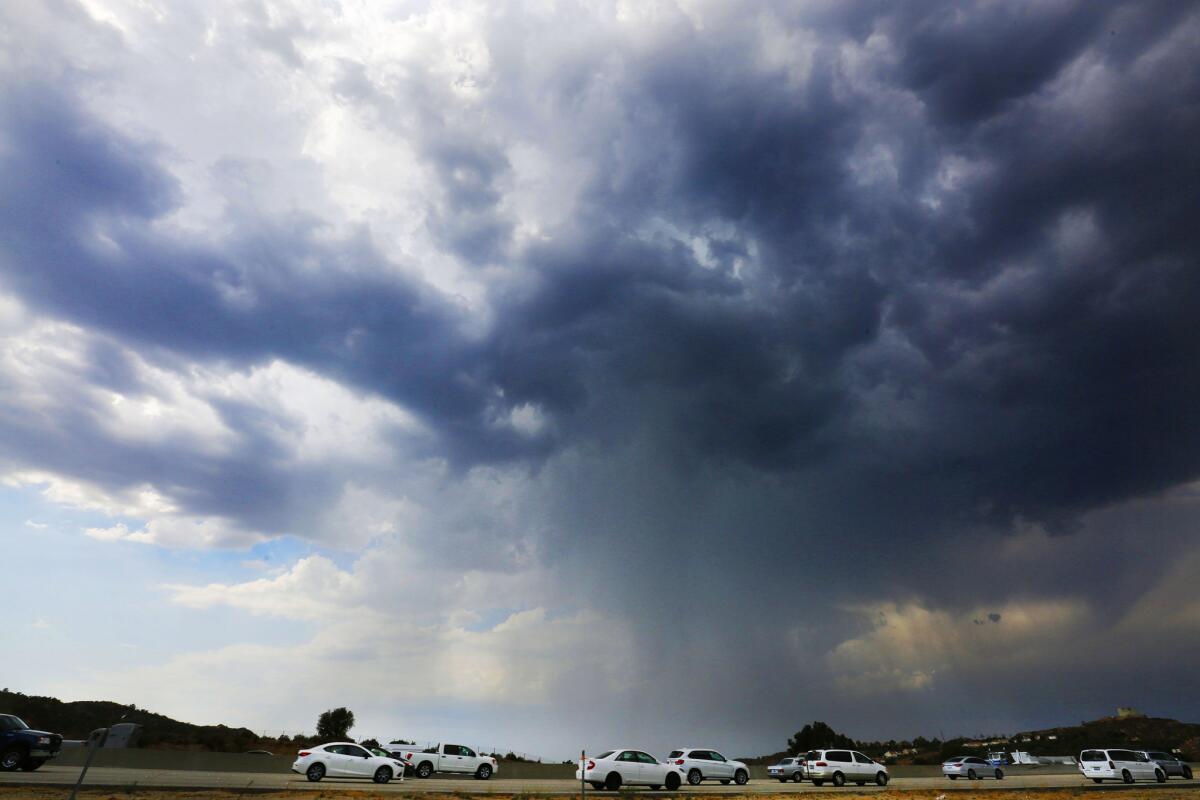El Niño-fueled summer storms helped reduce smog in Southern California

Storm clouds loom over Highway 14 near Santa Clarita on Sept. 9, 2015, as rain moves through the area.
- Share via
Rare summer rainstorms fueled by a strengthening El Niño helped Southern Californians breathe easier this year by sweeping away smog, air quality officials say.
The region had nine fewer bad air days during this year’s summer smog season than in 2014, according to the South Coast Air Quality Management District.
There were 83 days when ozone, the lung-damaging ingredient in smog, exceeded federal health standards, down from 92 days in 2014.
Water and Power is The Times’ guide to the drought. Sign up to get the free newsletter >>
The air quality gains should come as welcome news following an upswing in pollution over the previous two years that California regulators have blamed on the dry, stagnant weather of the drought.
While emissions reductions are driving a long-term decline in air pollution, some of this year’s improvements have the signature of El Niño, the weather-altering climate pattern that is gaining steam in the Pacific Ocean, said Joe Cassmassi, a meteorologist who is planning and rules director for the South Coast air district.
Warm ocean waters from the developing El Niño sent moisture-laden tropical storms through Southern California in July and September, stirring up the air and flushing out pollution at a time when hot, stagnant conditions usually push ozone to its highest levels, Cassmassi said.
“This year with El Niño, it disrupts the pattern,” Cassmassi said.
Cassmassi hopes El Niño will bring more pollution-clearing rainstorms in the coming months and cut down on bad air days this winter and next summer. That’s what happened with the robust El Niño of 1982-83, he said. “Ozone values dipped precipitously.”
The region could use nature’s assistance. Despite sharp improvement in air quality from decades of emissions-cutting regulations, the Southland still has the nation’s worst smog and has failed to meet a series of federal health standards.
The South Coast air district has blamed the drought for missing a 2015 deadline to clean fine-particle pollution, or soot, that builds up during the winter. But environmentalists fault the agency for not doing enough to cut pollution and accuse officials of essentially waiting for rain to clean the air.
“Eighty-something bad air days is still not something to be proud of,” said Allen Hernandez, an organizer for the Sierra Club in the smoggy Inland Empire. “If they are serious about reducing bad air days they can prove it with tougher restrictions on gas plants and refineries that are hurting our communities.”
Adding to the challenge is the decision last month by the U.S. Environmental Protection Agency to strengthen the limit on ozone from 75 parts per billion to 70 parts per billion. Under the new standard that takes effect on Dec. 28, the South Coast air basin would have had 113 bad air days over the 184-day May-to-October smog season.
For more air quality and environment news, follow me @tonybarboza
ALSO:
Student shot and killed by police after stabbing four on UC Merced campus
Sacramento police arrest suspect in stabbing of French train attack hero Spencer Stone
More to Read
Sign up for Essential California
The most important California stories and recommendations in your inbox every morning.
You may occasionally receive promotional content from the Los Angeles Times.











